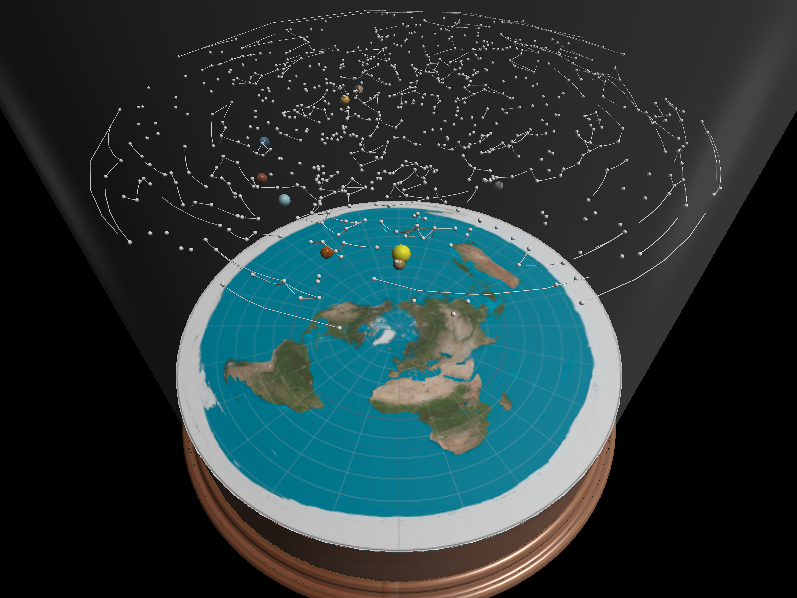1
Flat Earth Theory / Re: Found a fully working flat earth model?
« on: May 07, 2022, 10:00:06 AM »
I believe there are still a few nuances in the way how i see this model versus how many posters view it.
Personally i don't think there has been enough emphasis on the fact that this model can be, and in fact was originally empirically derived.
2000 years ago, the Greeks made an incompleteness error: They assumed a globe and straight light and showed it was consistent with measurements in reality.
However, what they really measured was the relationship between light and earth shape. The earth shape was an assumption.
For my approach i've started over, but this time assuming a flat earth (later to be generalized to shape-agnostic)
I've started with the observation of horizon distance: ie that the formula R/cos(phi) - R defines the relation between earth-shape and light-ray shape (basically height difference between a laser and a lake).
From this formula (and assuming a flat earth it's possible to create an explanation for day, night, seasons, .....)
In fact i believe it's possible to rederive all of physics this way without relying on the globe, at all.
At this point we have created an alternative model to the globe model and then there are 2 possibilities:
- we find a difference between both models and derive a test to see which one is correct
- both models are equivalent
In this case the latter can be proven. In history this has happened multiple times before. Think of the ptolemaic and tychonic models for planetary motion. It can be shown both are equivalent/approximations of the globe model)
In all posts so far, there has been a lot of emphasis on the equivalence with the globe model (as it's vastly easier to explain what's happening this way than having to rederive 2000 years of gnarly mathematics
Personally i do believe it is correct to call this a "flat earth model" (tough i admit there's a a bit of semantics involved)
Diving into this i've also discovered that the flat earth debate is a lot more nuanced than i initially thought. For example a picture of globe earth from space or a ship disappearing hull first are not actually proofs of intrinsic curvature for example and this is not something i would have guessed before this post.
And then there are of course the more philosophical questions about what it means to have 2 differently shaped models.
I also see this work as a potential bridge between RE and FE. When we see a ship disappearing hull first behind the horizon, and the globies and flatiies start warring whether it's the globe, the light or the aether that's curving, we now know they're really in agreement.
Personally i don't think there has been enough emphasis on the fact that this model can be, and in fact was originally empirically derived.
2000 years ago, the Greeks made an incompleteness error: They assumed a globe and straight light and showed it was consistent with measurements in reality.
However, what they really measured was the relationship between light and earth shape. The earth shape was an assumption.
For my approach i've started over, but this time assuming a flat earth (later to be generalized to shape-agnostic)
I've started with the observation of horizon distance: ie that the formula R/cos(phi) - R defines the relation between earth-shape and light-ray shape (basically height difference between a laser and a lake).
From this formula (and assuming a flat earth it's possible to create an explanation for day, night, seasons, .....)
In fact i believe it's possible to rederive all of physics this way without relying on the globe, at all.
At this point we have created an alternative model to the globe model and then there are 2 possibilities:
- we find a difference between both models and derive a test to see which one is correct
- both models are equivalent
In this case the latter can be proven. In history this has happened multiple times before. Think of the ptolemaic and tychonic models for planetary motion. It can be shown both are equivalent/approximations of the globe model)
In all posts so far, there has been a lot of emphasis on the equivalence with the globe model (as it's vastly easier to explain what's happening this way than having to rederive 2000 years of gnarly mathematics

Personally i do believe it is correct to call this a "flat earth model" (tough i admit there's a a bit of semantics involved)
Diving into this i've also discovered that the flat earth debate is a lot more nuanced than i initially thought. For example a picture of globe earth from space or a ship disappearing hull first are not actually proofs of intrinsic curvature for example and this is not something i would have guessed before this post.
And then there are of course the more philosophical questions about what it means to have 2 differently shaped models.
I also see this work as a potential bridge between RE and FE. When we see a ship disappearing hull first behind the horizon, and the globies and flatiies start warring whether it's the globe, the light or the aether that's curving, we now know they're really in agreement.

